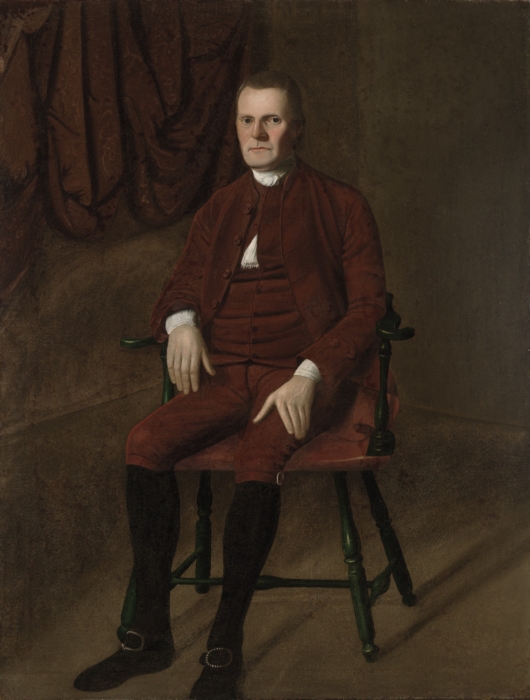Roger Sherman was a lawyer and statesman during colonial America. He is the only person to have signed all four of the United States’ great state papers: the Continental Association, the Declaration of Independence, the Articles of Confederation, and the United States Constitution. He also served alongside Thomas Jefferson, John Adams, Benjamin Franklin, and Robert Livingston on the Committee of Five who drafted the Declaration of Independence. Sherman was a Senator and Representative from Connecticut following the ratification of the Constitution.
On April 19, 1721, Roger Sherman was born to William and Mehetabel Sherman on their farm in Newton, Massachusetts. They had seven children together: William Jr., Mehetabel, Roger, Elizabeth, Nathaniel, Josiah, and Rebecca. In 1723, the family left Newton and moved to Dorchester after the birth of Elizabeth. Three years later, Dorchester because known as the town of Stoughton.
Growing up, Sherman was educated through his father’s library and by the local grammar school. He worked as a shoe maker at a young age, but preferred to spend time in his father’s library and the library of Rev. Samuel Dunbar.
Sherman’s father died in 1743, and he, along with his mother and siblings, moved on foot to New Milford, Connecticut. There, Sherman and his brother William opened the first store in the tiny town. He soon became one of the leading citizens in the town. This was because he had quickly started to introduce himself to the other townspeople and in religious and civil affairs. Sherman was especially skilled when it came to math,and due to this, became the county surveyor in 1745 for New Haven County. Over a decade later in 1759, he had also started to provide almanacs with astronomical calculations.
On November 17, 1749, Roger Sherman married Elizabeth Hartwell (1726-1760) in Stoughton by Rev. Samuel Dunbar. Together they had seven children before she died on October 19, 1760.
Sherman married a second time on May 12, 1763 to Rebecca Prescott (1742-1814). They had eight children, two of which died in infancy. Rebecca outlived her husband by many years, dying in August of 1814.

The Committee of Five. From left to right: John Adams, Roger Sherman, Robert Livingston, Thomas Jefferson, and Benjamin Franklin. Source: wikipedia.org
Sherman is best known for signing all four great papers of the United States. These include the Continental Association (or Articles of Association), the Declaration of Independence, the Articles of Confederation, and the United States Constitution. Because of this, he is considered to be a Founding Father, however, he is not one of the key seven founding fathers. He also never went to law school or had any formal training in law for that matter either, but passed the bar exam and became a lawyer in 1754 in Litchfield, Connecticut. From 1755-1758 and again from 1760-61, he represented New Milford in the Connecticut House of Representatives.
In 1762, Sherman was appointed justice of the peace. Three years later, he was then appointed to be judge of the court of common pleas. Sherman was elected in 1766 to the Governor’s Council of the Connecticut General Assembly. He served there until 1785. Not only that, but he was also appointed to be the treasurer for Yale College. There, he was awarded with an honorary Master of Arts degree. For many years, he taught religion as well. In 1784, he was elected Mayor of New Haven, a position which he kept until his death in 1793.
Along with George Wythe and John Adams, Sherman was on a committee responsible for establishing U.S. embassy officials in Canada’s guidelines.
Sherman attended the Constitutional Convention in 1787 and was one of the convention’s most influential members. However, he was considered to be a “tersely eloquent speaker” and is therefore not remembered for his actions. He also did not record the experience like most other notable figures there. Sherman made motions or seconds 160 times in reference to the Virginia Plan, while his opponent, James Madison, made 177 motions or seconds.
When the convention began, Sherman saw it as a time to modify the Articles of Confederation, of which he had been a part of creating, and not to create a new constitution. He defended the articles, saying that it was in the best interest of the people to revise them instead of creating a new constitution all together. Sherman opposed the Virginia Plan, seeing no need for a legislature made up of two different branches. Instead, he was in favor of a unicameral legislature. Sherman also believed that the people should not vote in election and instead state officials should do so.
In the Virginia plan, the country would have a bicameral legislature and both chambers would be represented by each state according to population. The New Jersey plan outlined a unicameral legislature that was represented by each state equally. Though Sherman preferred having a unicameral legislature, he knew that that would not happen, so instead began looking for a compromise. Him and Oliver Ellsworth came up with the Great Compromise, or Connecticut Compromise. The new plan was designed to accommodate both large and small states. In one branch, each state would be represented proportionally by population, which was the House of Representatives. In the upper house, the Senate, each state would be represented equally with two representatives.
Sherman was in opposition to slavery since it disagreed with his personal and puritan beliefs. However, he used the issue as a tool when negotiating. He also believed that by that time, it was slowly being abolished and the idea of abolishing it was moving down more towards the south.
On July 23, 1793, Roger Sherman died in his sleep after being ill for two months with a diagnosis of typhoid fever. He was buried in New Haven, where he was also the mayor of, and his remains were later moved to the Grove Street Cemetery in 1821.


